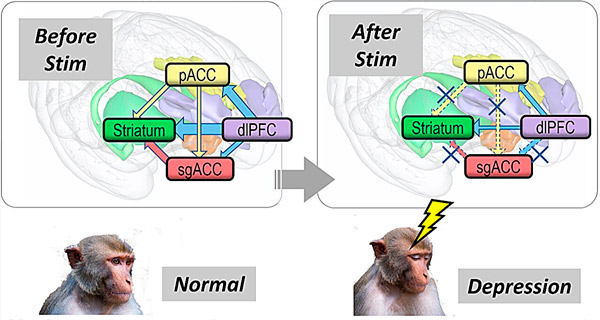New publications
Downstream signals in brain circuits regulating depression discovered
Last reviewed: 02.07.2025

All iLive content is medically reviewed or fact checked to ensure as much factual accuracy as possible.
We have strict sourcing guidelines and only link to reputable media sites, academic research institutions and, whenever possible, medically peer reviewed studies. Note that the numbers in parentheses ([1], [2], etc.) are clickable links to these studies.
If you feel that any of our content is inaccurate, out-of-date, or otherwise questionable, please select it and press Ctrl + Enter.

Understanding and treating depression, a potentially debilitating mental health condition that affects millions of people worldwide, remains a priority among neuroscience researchers. Major depressive disorder (MDD), for example, affects about 33 million people, or about 5% of the world’s adult population.
Emotion regulation is an important brain function that helps suppress emotions and depression, and is thought to be a protective mechanism in MDD. However, the neurobiological mechanisms underlying how the brain regulates depression are still unclear.
To explore this issue, a recent study led by Satoko Amemori and Ken-ichi Amemori and published in the journal Nature Communications examined how specific brain circuits regulate emotional responses, providing new insights into the neural basis of depression.
In this study, the researchers focused on the dorsolateral prefrontal cortex (dlPFC), which has long been known to play a role in emotion regulation. The researchers examined how the dlPFC signal changes in depression and elucidated the mechanism by which the dlPFC regulates the cingulostriatal network.
Uncovering the neural mechanisms underlying depressive behavior in primates may lay the foundation for developing new therapeutic approaches that target specific brain circuits.
The study examined the so-called "top-down influence" of the dlPFC on the cingulostriatal network, which is associated with depression, in the context of emotional regulation. The scientists also examined how these circuits influence decision-making and emotional responses.
Using microstimulation techniques, the researchers modified neural activity in the subgenual anterior cingulate cortex (sgACC) in rhesus monkeys (Macaca mulatta) and were able to experimentally induce pessimistic decision making and depressive states.
During these stimulation experiments, the researchers also recorded local field potentials (LFPs) to analyze the top-down influence of the dlPFC on the cingulostriatal network.
They found that experimentally induced pessimistic decision making was accompanied by reduced top-down dlPFC input to cingulostriatal regions.
This finding suggests that disruption of the top-down signal from cognition to emotion may lead to pessimistic decision making, which is a characteristic feature of MDD.
One of the key findings of the study was the role of beta oscillations in frontostriatal circuits. Beta oscillations have long been associated with motor control and attention, and more recently they have also been linked to cognitive functions such as working memory.
In this new study, effective microstimulation of the sgACC, which induces a depressive state, reduced the magnitude of beta oscillations encoding positive variables related to decision making.

Stim: microstimulation, dlPFC: dorsolateral prefrontal cortex, pACC: pregenual anterior cingulate cortex, sgACC: subgenual anterior cingulate cortex.
Source: Nature Communications (2024). DOI: 10.1038/s41467-024-48375-1
This reduction in beta oscillations is important because it suggests a link between sgACC activity and negativity bias in decision making, providing a potential mechanism for how the brain processes positive and negative values.
The study also examined interactions between regions within the fronto-cingulostriatal network. By examining factors such as coherence and Granger causality (a statistical test to determine whether a variable can be meaningfully described as a dependent variable), the researchers found that effective microstimulation of the sgACC altered these interactions, reflecting the network’s involvement in decision-making.
They found that dlPFC "top-down influence" on the cingulostriatal network was encoded by LFP beta oscillations, and decreased top-down influence was associated with experimentally induced depression.
These findings highlight the important role of this network in emotion regulation and decision making, and how its dysfunction may lead to depressive behavior.
This study provides valuable insights into the neural basis of depression, highlighting the role of specific brain circuits in regulating emotional responses. Importantly, the study created a primate model of depression and showed that fronto-cingulo-striatal circuits are involved in regulating the limbic system via beta oscillations.
Importantly, the researchers were able to demonstrate that monkeys exhibit depressive behavior in the absence of this regulation. By uncovering the mechanisms underlying depressive behavior in primates, this study opens new avenues for developing more effective treatments for MDD.
